High-Performance HR, Innovation, and Job Performance: A Study
VerifiedAdded on 2022/08/14
|38
|9548
|22
Report
AI Summary
This research report delves into the intricate relationships between high-performance HR practices, innovative work behavior, and employee job performance, with a specific focus on the mediating role of person-organization (P-O) fit. The study, conducted through an online survey of 216 participants, employs factor analysis to validate the proposed model. The findings highlight P-O fit as a critical factor influencing high-performance HR practices, innovative organizational behavior, and overall job performance. The research emphasizes the importance of organizations prioritizing P-O fit to enhance workforce efficiency and profitability. While the study acknowledges limitations, such as sample saturation in specific industries and potential self-reflection biases in data collection, it provides valuable insights into how organizations can leverage HR practices and foster a culture of innovation to improve employee outcomes.
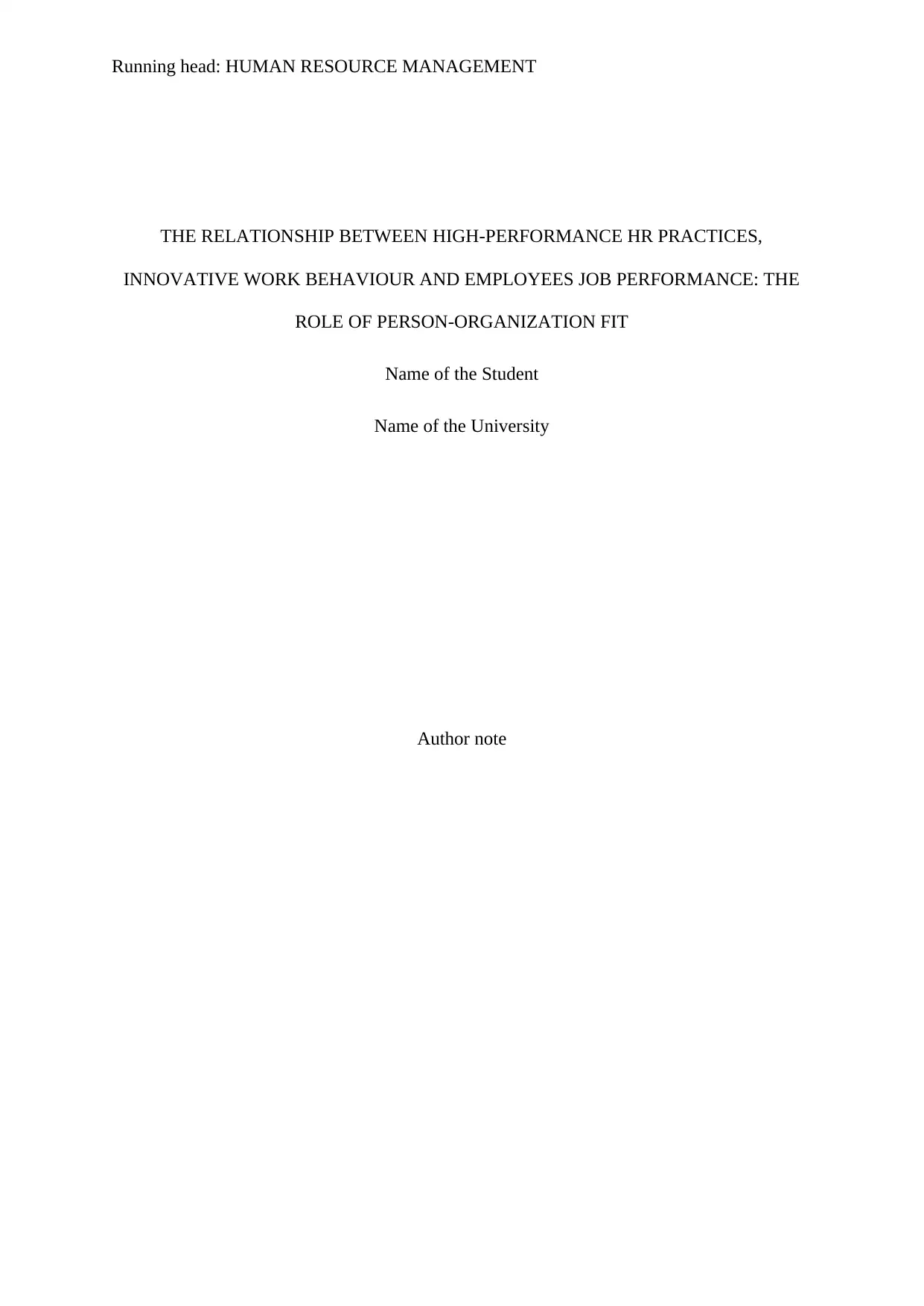
Running head: HUMAN RESOURCE MANAGEMENT
THE RELATIONSHIP BETWEEN HIGH-PERFORMANCE HR PRACTICES,
INNOVATIVE WORK BEHAVIOUR AND EMPLOYEES JOB PERFORMANCE: THE
ROLE OF PERSON-ORGANIZATION FIT
Name of the Student
Name of the University
Author note
THE RELATIONSHIP BETWEEN HIGH-PERFORMANCE HR PRACTICES,
INNOVATIVE WORK BEHAVIOUR AND EMPLOYEES JOB PERFORMANCE: THE
ROLE OF PERSON-ORGANIZATION FIT
Name of the Student
Name of the University
Author note
Paraphrase This Document
Need a fresh take? Get an instant paraphrase of this document with our AI Paraphraser
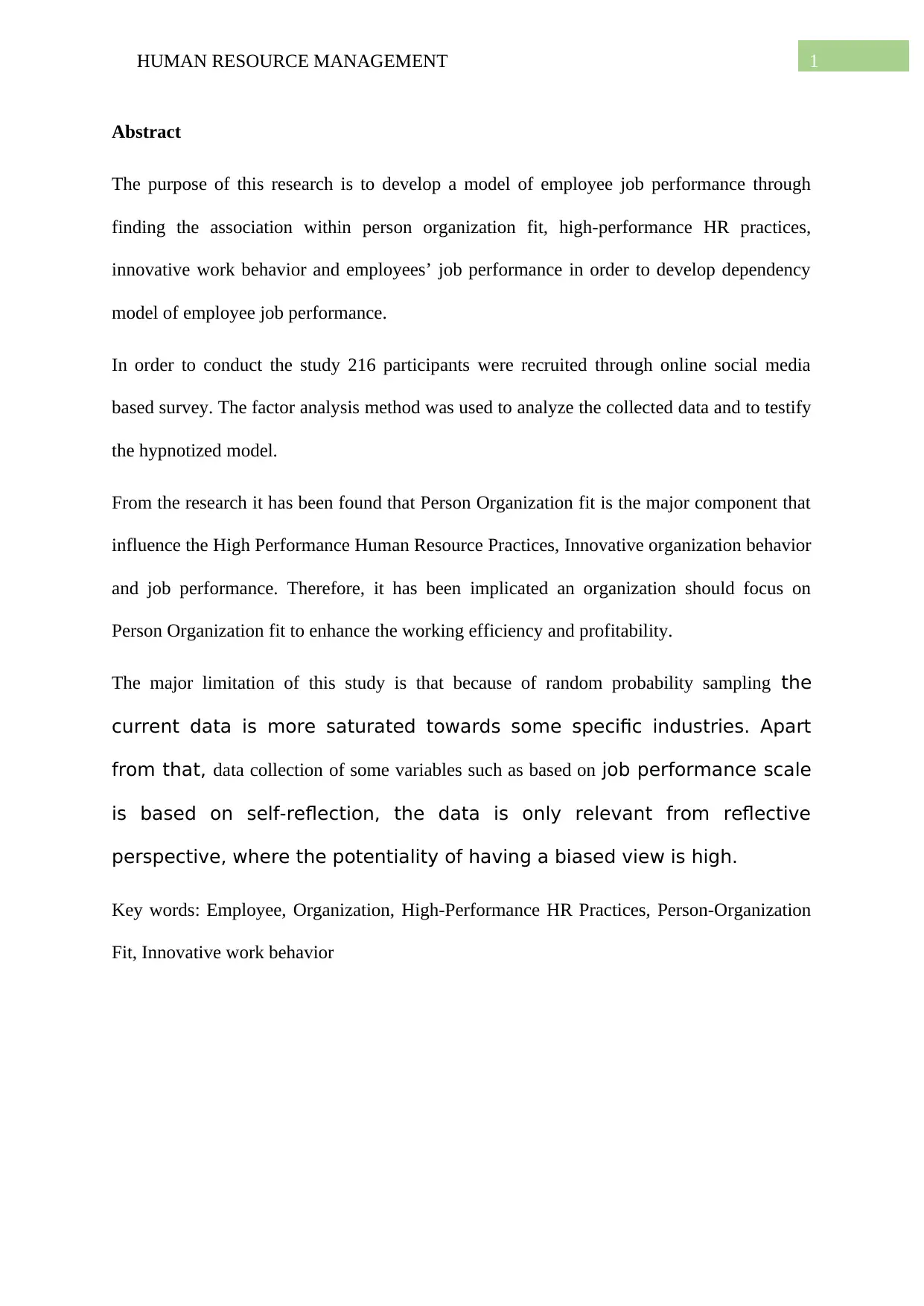
1HUMAN RESOURCE MANAGEMENT
Abstract
The purpose of this research is to develop a model of employee job performance through
finding the association within person organization fit, high-performance HR practices,
innovative work behavior and employees’ job performance in order to develop dependency
model of employee job performance.
In order to conduct the study 216 participants were recruited through online social media
based survey. The factor analysis method was used to analyze the collected data and to testify
the hypnotized model.
From the research it has been found that Person Organization fit is the major component that
influence the High Performance Human Resource Practices, Innovative organization behavior
and job performance. Therefore, it has been implicated an organization should focus on
Person Organization fit to enhance the working efficiency and profitability.
The major limitation of this study is that because of random probability sampling the
current data is more saturated towards some specific industries. Apart
from that, data collection of some variables such as based on job performance scale
is based on self-reflection, the data is only relevant from reflective
perspective, where the potentiality of having a biased view is high.
Key words: Employee, Organization, High-Performance HR Practices, Person-Organization
Fit, Innovative work behavior
Abstract
The purpose of this research is to develop a model of employee job performance through
finding the association within person organization fit, high-performance HR practices,
innovative work behavior and employees’ job performance in order to develop dependency
model of employee job performance.
In order to conduct the study 216 participants were recruited through online social media
based survey. The factor analysis method was used to analyze the collected data and to testify
the hypnotized model.
From the research it has been found that Person Organization fit is the major component that
influence the High Performance Human Resource Practices, Innovative organization behavior
and job performance. Therefore, it has been implicated an organization should focus on
Person Organization fit to enhance the working efficiency and profitability.
The major limitation of this study is that because of random probability sampling the
current data is more saturated towards some specific industries. Apart
from that, data collection of some variables such as based on job performance scale
is based on self-reflection, the data is only relevant from reflective
perspective, where the potentiality of having a biased view is high.
Key words: Employee, Organization, High-Performance HR Practices, Person-Organization
Fit, Innovative work behavior
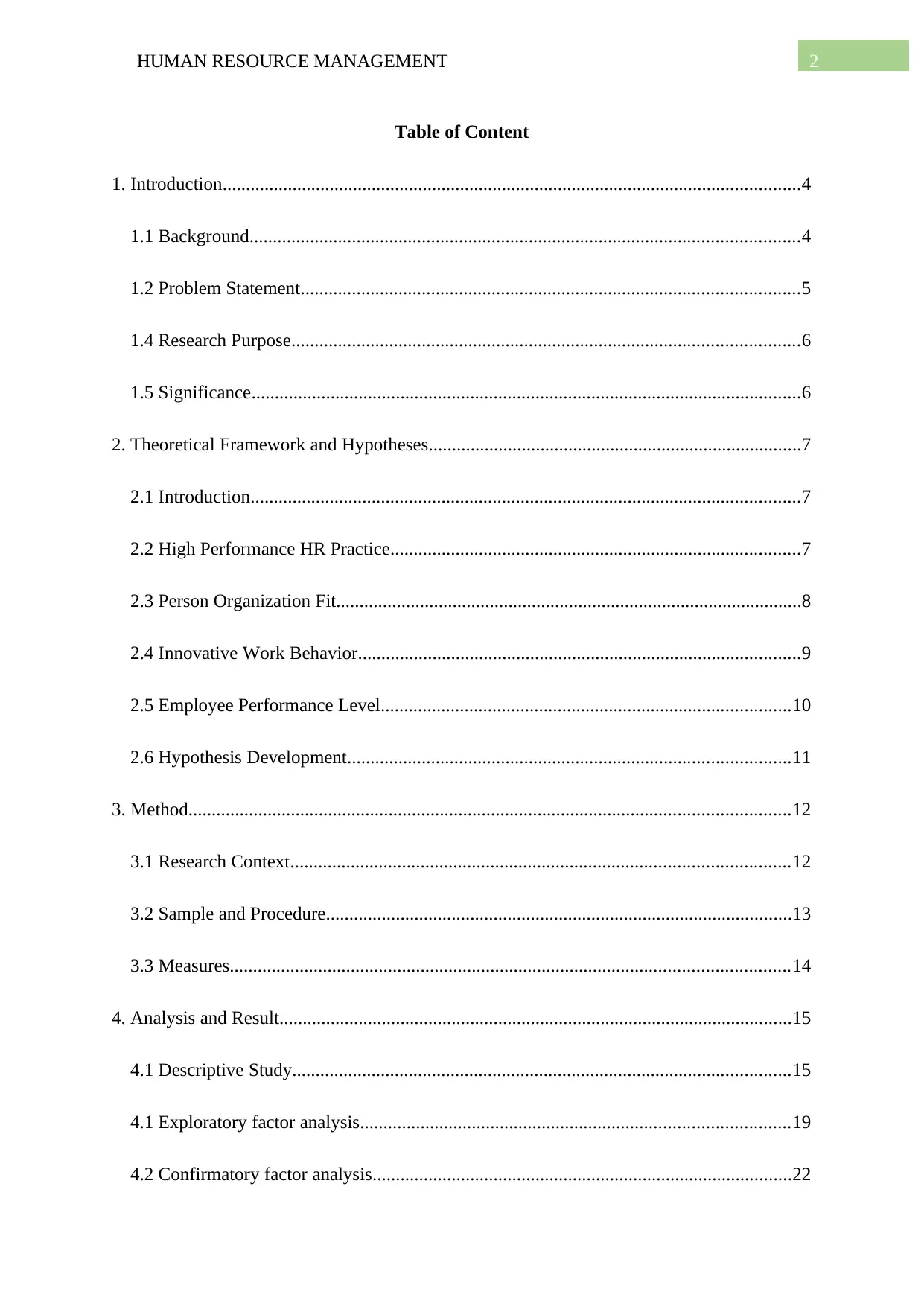
2HUMAN RESOURCE MANAGEMENT
Table of Content
1. Introduction............................................................................................................................4
1.1 Background......................................................................................................................4
1.2 Problem Statement...........................................................................................................5
1.4 Research Purpose.............................................................................................................6
1.5 Significance......................................................................................................................6
2. Theoretical Framework and Hypotheses................................................................................7
2.1 Introduction......................................................................................................................7
2.2 High Performance HR Practice........................................................................................7
2.3 Person Organization Fit....................................................................................................8
2.4 Innovative Work Behavior...............................................................................................9
2.5 Employee Performance Level........................................................................................10
2.6 Hypothesis Development...............................................................................................11
3. Method.................................................................................................................................12
3.1 Research Context...........................................................................................................12
3.2 Sample and Procedure....................................................................................................13
3.3 Measures........................................................................................................................14
4. Analysis and Result..............................................................................................................15
4.1 Descriptive Study...........................................................................................................15
4.1 Exploratory factor analysis............................................................................................19
4.2 Confirmatory factor analysis..........................................................................................22
Table of Content
1. Introduction............................................................................................................................4
1.1 Background......................................................................................................................4
1.2 Problem Statement...........................................................................................................5
1.4 Research Purpose.............................................................................................................6
1.5 Significance......................................................................................................................6
2. Theoretical Framework and Hypotheses................................................................................7
2.1 Introduction......................................................................................................................7
2.2 High Performance HR Practice........................................................................................7
2.3 Person Organization Fit....................................................................................................8
2.4 Innovative Work Behavior...............................................................................................9
2.5 Employee Performance Level........................................................................................10
2.6 Hypothesis Development...............................................................................................11
3. Method.................................................................................................................................12
3.1 Research Context...........................................................................................................12
3.2 Sample and Procedure....................................................................................................13
3.3 Measures........................................................................................................................14
4. Analysis and Result..............................................................................................................15
4.1 Descriptive Study...........................................................................................................15
4.1 Exploratory factor analysis............................................................................................19
4.2 Confirmatory factor analysis..........................................................................................22
⊘ This is a preview!⊘
Do you want full access?
Subscribe today to unlock all pages.

Trusted by 1+ million students worldwide
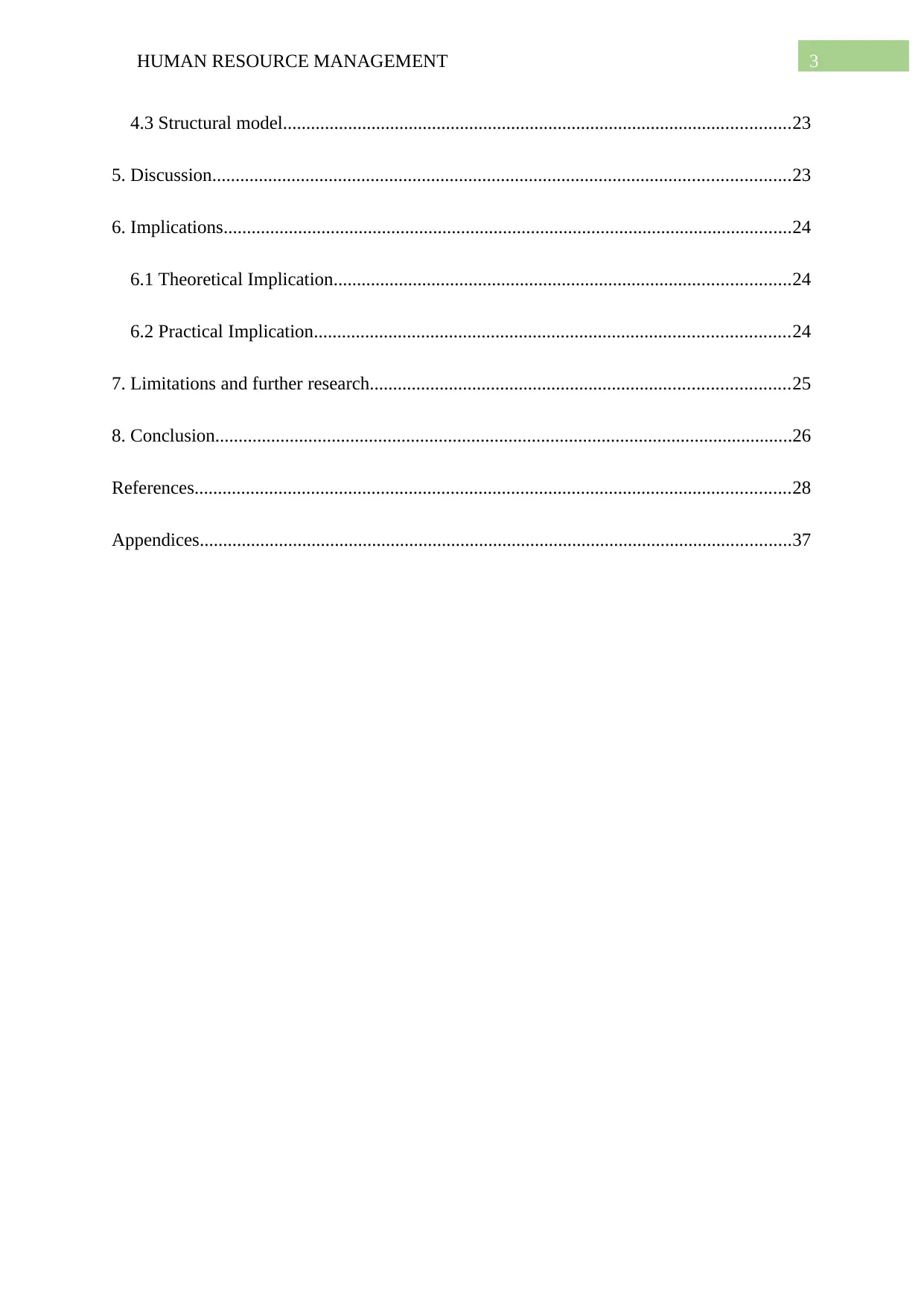
3HUMAN RESOURCE MANAGEMENT
4.3 Structural model.............................................................................................................23
5. Discussion............................................................................................................................23
6. Implications..........................................................................................................................24
6.1 Theoretical Implication..................................................................................................24
6.2 Practical Implication......................................................................................................24
7. Limitations and further research..........................................................................................25
8. Conclusion............................................................................................................................26
References................................................................................................................................28
Appendices...............................................................................................................................37
4.3 Structural model.............................................................................................................23
5. Discussion............................................................................................................................23
6. Implications..........................................................................................................................24
6.1 Theoretical Implication..................................................................................................24
6.2 Practical Implication......................................................................................................24
7. Limitations and further research..........................................................................................25
8. Conclusion............................................................................................................................26
References................................................................................................................................28
Appendices...............................................................................................................................37
Paraphrase This Document
Need a fresh take? Get an instant paraphrase of this document with our AI Paraphraser
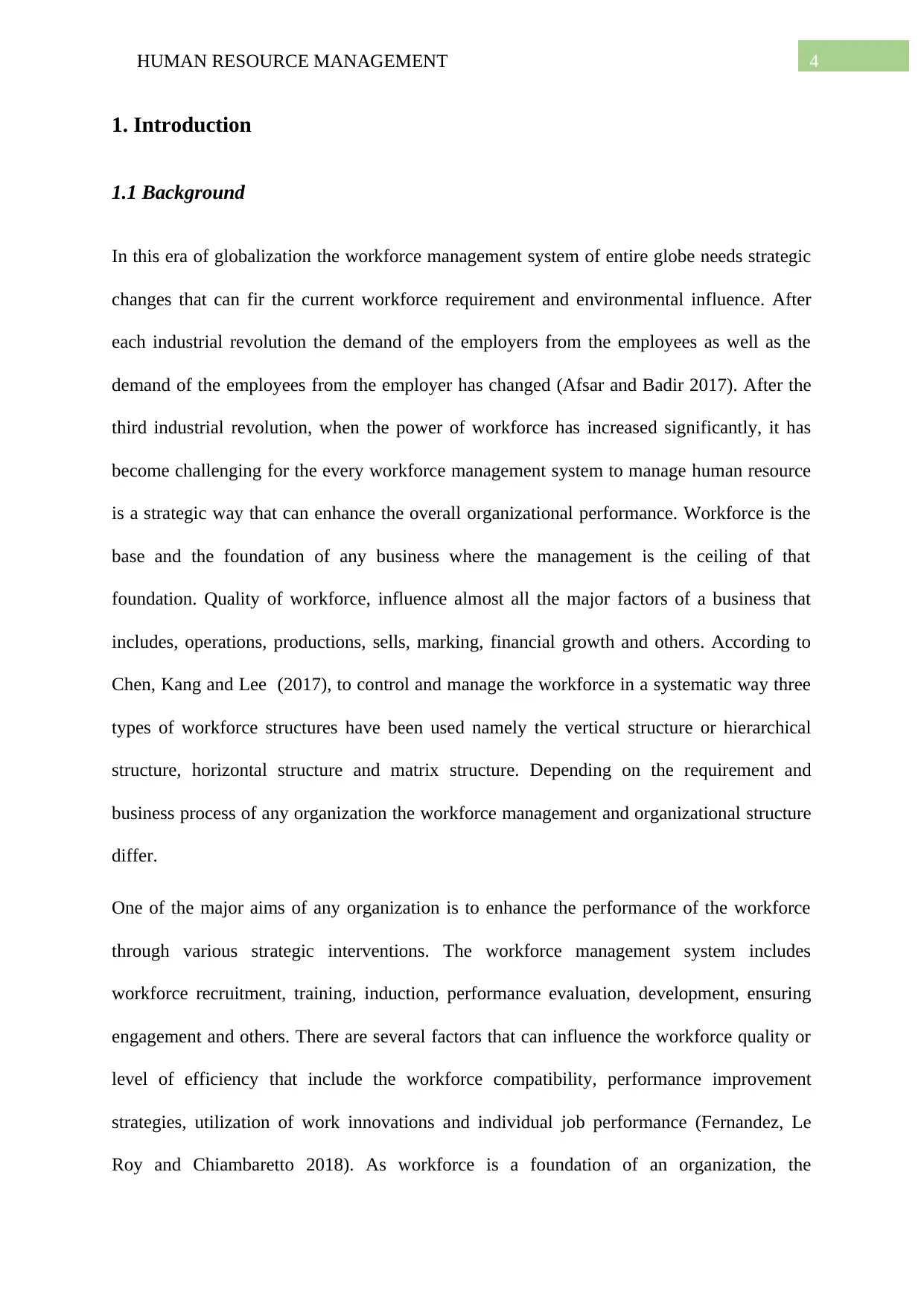
4HUMAN RESOURCE MANAGEMENT
1. Introduction
1.1 Background
In this era of globalization the workforce management system of entire globe needs strategic
changes that can fir the current workforce requirement and environmental influence. After
each industrial revolution the demand of the employers from the employees as well as the
demand of the employees from the employer has changed (Afsar and Badir 2017). After the
third industrial revolution, when the power of workforce has increased significantly, it has
become challenging for the every workforce management system to manage human resource
is a strategic way that can enhance the overall organizational performance. Workforce is the
base and the foundation of any business where the management is the ceiling of that
foundation. Quality of workforce, influence almost all the major factors of a business that
includes, operations, productions, sells, marking, financial growth and others. According to
Chen, Kang and Lee (2017), to control and manage the workforce in a systematic way three
types of workforce structures have been used namely the vertical structure or hierarchical
structure, horizontal structure and matrix structure. Depending on the requirement and
business process of any organization the workforce management and organizational structure
differ.
One of the major aims of any organization is to enhance the performance of the workforce
through various strategic interventions. The workforce management system includes
workforce recruitment, training, induction, performance evaluation, development, ensuring
engagement and others. There are several factors that can influence the workforce quality or
level of efficiency that include the workforce compatibility, performance improvement
strategies, utilization of work innovations and individual job performance (Fernandez, Le
Roy and Chiambaretto 2018). As workforce is a foundation of an organization, the
1. Introduction
1.1 Background
In this era of globalization the workforce management system of entire globe needs strategic
changes that can fir the current workforce requirement and environmental influence. After
each industrial revolution the demand of the employers from the employees as well as the
demand of the employees from the employer has changed (Afsar and Badir 2017). After the
third industrial revolution, when the power of workforce has increased significantly, it has
become challenging for the every workforce management system to manage human resource
is a strategic way that can enhance the overall organizational performance. Workforce is the
base and the foundation of any business where the management is the ceiling of that
foundation. Quality of workforce, influence almost all the major factors of a business that
includes, operations, productions, sells, marking, financial growth and others. According to
Chen, Kang and Lee (2017), to control and manage the workforce in a systematic way three
types of workforce structures have been used namely the vertical structure or hierarchical
structure, horizontal structure and matrix structure. Depending on the requirement and
business process of any organization the workforce management and organizational structure
differ.
One of the major aims of any organization is to enhance the performance of the workforce
through various strategic interventions. The workforce management system includes
workforce recruitment, training, induction, performance evaluation, development, ensuring
engagement and others. There are several factors that can influence the workforce quality or
level of efficiency that include the workforce compatibility, performance improvement
strategies, utilization of work innovations and individual job performance (Fernandez, Le
Roy and Chiambaretto 2018). As workforce is a foundation of an organization, the
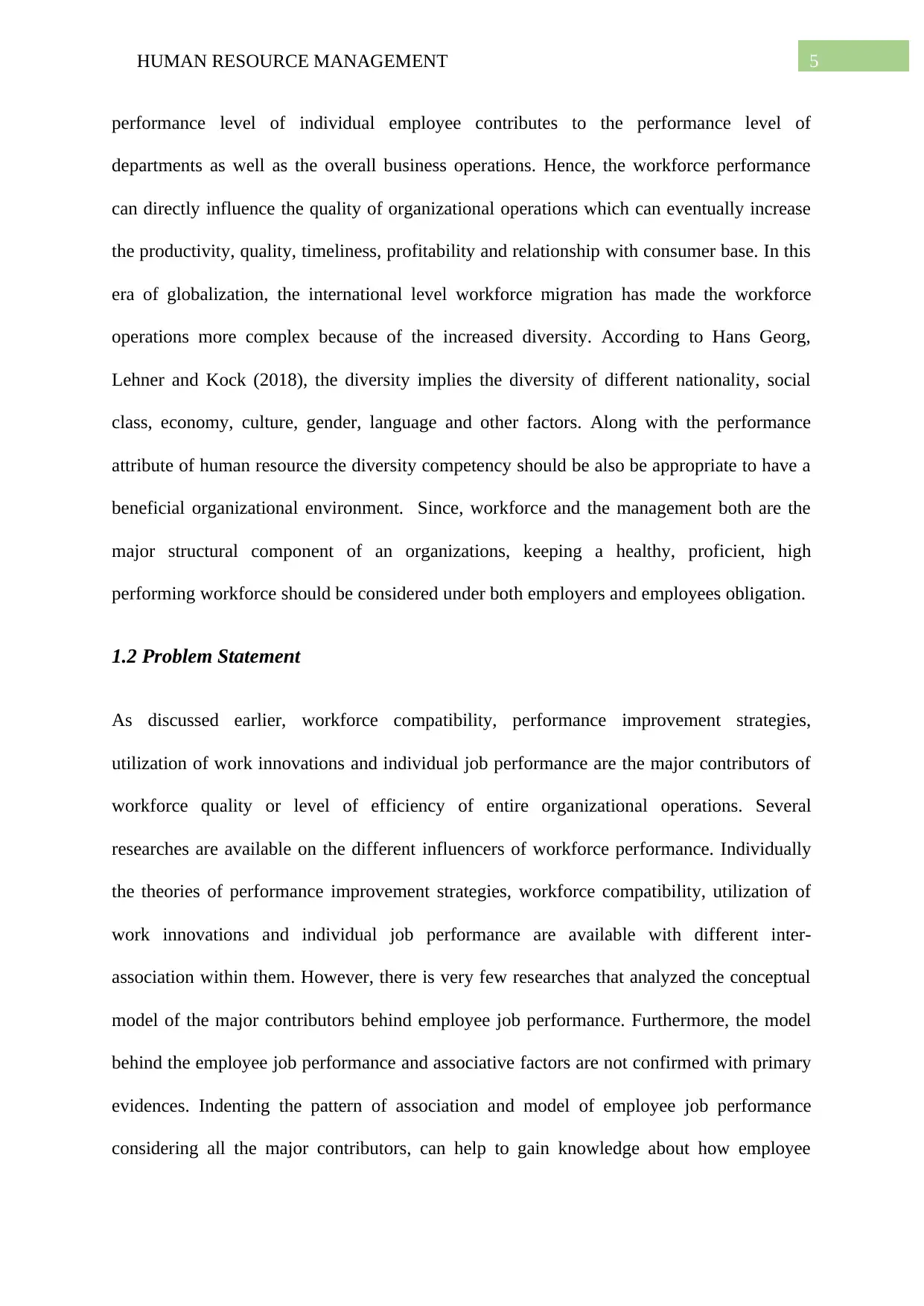
5HUMAN RESOURCE MANAGEMENT
performance level of individual employee contributes to the performance level of
departments as well as the overall business operations. Hence, the workforce performance
can directly influence the quality of organizational operations which can eventually increase
the productivity, quality, timeliness, profitability and relationship with consumer base. In this
era of globalization, the international level workforce migration has made the workforce
operations more complex because of the increased diversity. According to Hans Georg,
Lehner and Kock (2018), the diversity implies the diversity of different nationality, social
class, economy, culture, gender, language and other factors. Along with the performance
attribute of human resource the diversity competency should be also be appropriate to have a
beneficial organizational environment. Since, workforce and the management both are the
major structural component of an organizations, keeping a healthy, proficient, high
performing workforce should be considered under both employers and employees obligation.
1.2 Problem Statement
As discussed earlier, workforce compatibility, performance improvement strategies,
utilization of work innovations and individual job performance are the major contributors of
workforce quality or level of efficiency of entire organizational operations. Several
researches are available on the different influencers of workforce performance. Individually
the theories of performance improvement strategies, workforce compatibility, utilization of
work innovations and individual job performance are available with different inter-
association within them. However, there is very few researches that analyzed the conceptual
model of the major contributors behind employee job performance. Furthermore, the model
behind the employee job performance and associative factors are not confirmed with primary
evidences. Indenting the pattern of association and model of employee job performance
considering all the major contributors, can help to gain knowledge about how employee
performance level of individual employee contributes to the performance level of
departments as well as the overall business operations. Hence, the workforce performance
can directly influence the quality of organizational operations which can eventually increase
the productivity, quality, timeliness, profitability and relationship with consumer base. In this
era of globalization, the international level workforce migration has made the workforce
operations more complex because of the increased diversity. According to Hans Georg,
Lehner and Kock (2018), the diversity implies the diversity of different nationality, social
class, economy, culture, gender, language and other factors. Along with the performance
attribute of human resource the diversity competency should be also be appropriate to have a
beneficial organizational environment. Since, workforce and the management both are the
major structural component of an organizations, keeping a healthy, proficient, high
performing workforce should be considered under both employers and employees obligation.
1.2 Problem Statement
As discussed earlier, workforce compatibility, performance improvement strategies,
utilization of work innovations and individual job performance are the major contributors of
workforce quality or level of efficiency of entire organizational operations. Several
researches are available on the different influencers of workforce performance. Individually
the theories of performance improvement strategies, workforce compatibility, utilization of
work innovations and individual job performance are available with different inter-
association within them. However, there is very few researches that analyzed the conceptual
model of the major contributors behind employee job performance. Furthermore, the model
behind the employee job performance and associative factors are not confirmed with primary
evidences. Indenting the pattern of association and model of employee job performance
considering all the major contributors, can help to gain knowledge about how employee
⊘ This is a preview!⊘
Do you want full access?
Subscribe today to unlock all pages.

Trusted by 1+ million students worldwide
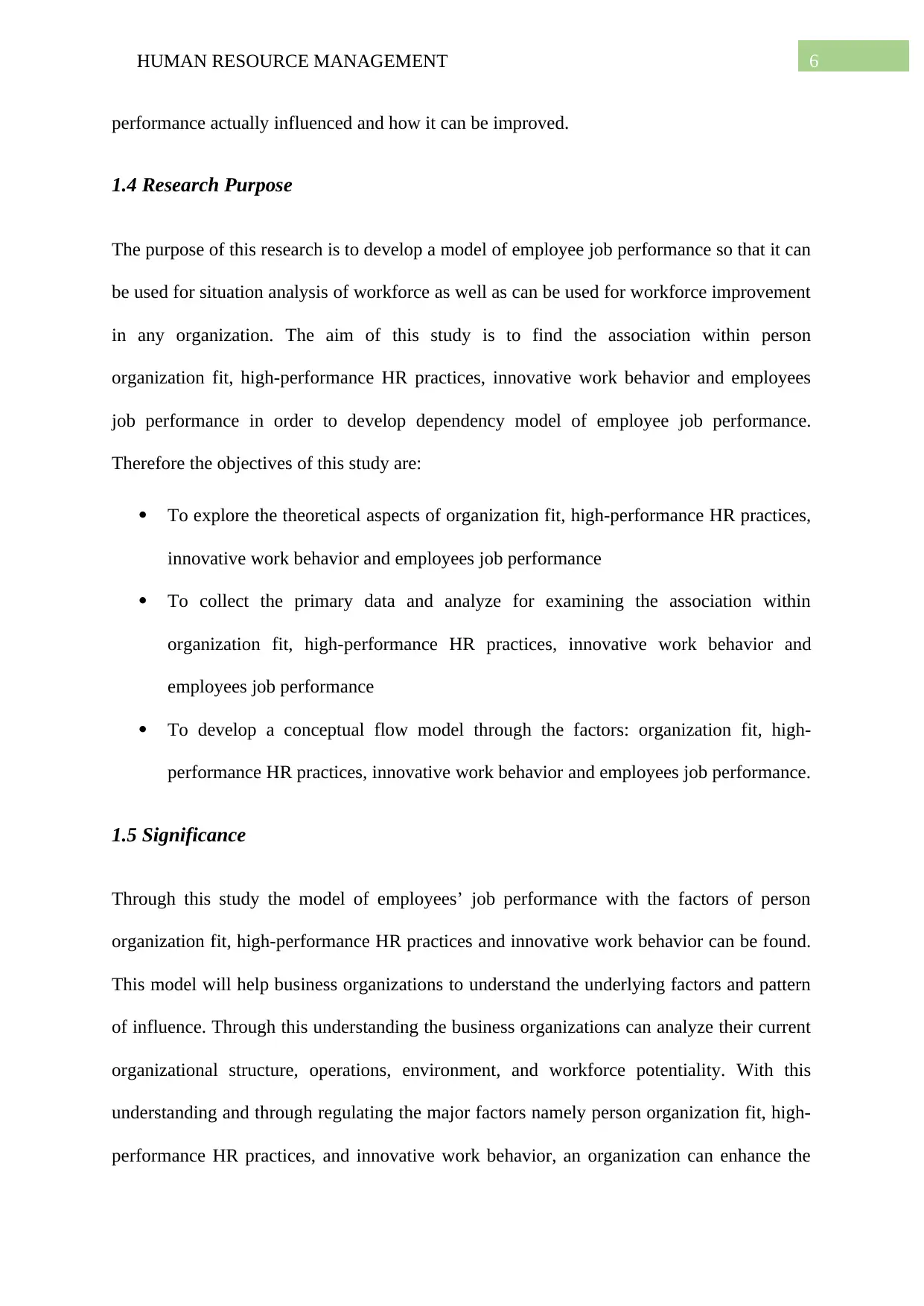
6HUMAN RESOURCE MANAGEMENT
performance actually influenced and how it can be improved.
1.4 Research Purpose
The purpose of this research is to develop a model of employee job performance so that it can
be used for situation analysis of workforce as well as can be used for workforce improvement
in any organization. The aim of this study is to find the association within person
organization fit, high-performance HR practices, innovative work behavior and employees
job performance in order to develop dependency model of employee job performance.
Therefore the objectives of this study are:
To explore the theoretical aspects of organization fit, high-performance HR practices,
innovative work behavior and employees job performance
To collect the primary data and analyze for examining the association within
organization fit, high-performance HR practices, innovative work behavior and
employees job performance
To develop a conceptual flow model through the factors: organization fit, high-
performance HR practices, innovative work behavior and employees job performance.
1.5 Significance
Through this study the model of employees’ job performance with the factors of person
organization fit, high-performance HR practices and innovative work behavior can be found.
This model will help business organizations to understand the underlying factors and pattern
of influence. Through this understanding the business organizations can analyze their current
organizational structure, operations, environment, and workforce potentiality. With this
understanding and through regulating the major factors namely person organization fit, high-
performance HR practices, and innovative work behavior, an organization can enhance the
performance actually influenced and how it can be improved.
1.4 Research Purpose
The purpose of this research is to develop a model of employee job performance so that it can
be used for situation analysis of workforce as well as can be used for workforce improvement
in any organization. The aim of this study is to find the association within person
organization fit, high-performance HR practices, innovative work behavior and employees
job performance in order to develop dependency model of employee job performance.
Therefore the objectives of this study are:
To explore the theoretical aspects of organization fit, high-performance HR practices,
innovative work behavior and employees job performance
To collect the primary data and analyze for examining the association within
organization fit, high-performance HR practices, innovative work behavior and
employees job performance
To develop a conceptual flow model through the factors: organization fit, high-
performance HR practices, innovative work behavior and employees job performance.
1.5 Significance
Through this study the model of employees’ job performance with the factors of person
organization fit, high-performance HR practices and innovative work behavior can be found.
This model will help business organizations to understand the underlying factors and pattern
of influence. Through this understanding the business organizations can analyze their current
organizational structure, operations, environment, and workforce potentiality. With this
understanding and through regulating the major factors namely person organization fit, high-
performance HR practices, and innovative work behavior, an organization can enhance the
Paraphrase This Document
Need a fresh take? Get an instant paraphrase of this document with our AI Paraphraser
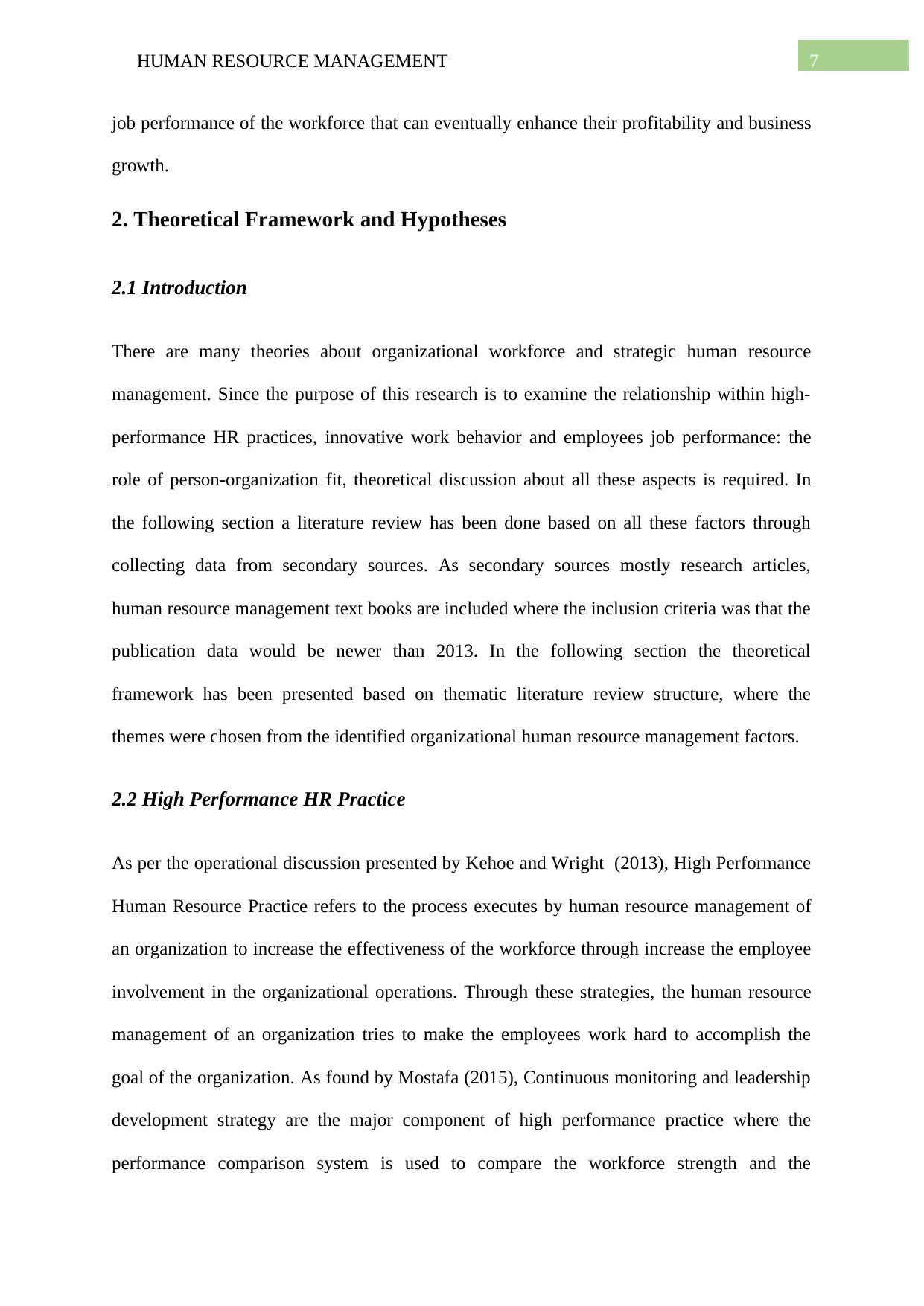
7HUMAN RESOURCE MANAGEMENT
job performance of the workforce that can eventually enhance their profitability and business
growth.
2. Theoretical Framework and Hypotheses
2.1 Introduction
There are many theories about organizational workforce and strategic human resource
management. Since the purpose of this research is to examine the relationship within high-
performance HR practices, innovative work behavior and employees job performance: the
role of person-organization fit, theoretical discussion about all these aspects is required. In
the following section a literature review has been done based on all these factors through
collecting data from secondary sources. As secondary sources mostly research articles,
human resource management text books are included where the inclusion criteria was that the
publication data would be newer than 2013. In the following section the theoretical
framework has been presented based on thematic literature review structure, where the
themes were chosen from the identified organizational human resource management factors.
2.2 High Performance HR Practice
As per the operational discussion presented by Kehoe and Wright (2013), High Performance
Human Resource Practice refers to the process executes by human resource management of
an organization to increase the effectiveness of the workforce through increase the employee
involvement in the organizational operations. Through these strategies, the human resource
management of an organization tries to make the employees work hard to accomplish the
goal of the organization. As found by Mostafa (2015), Continuous monitoring and leadership
development strategy are the major component of high performance practice where the
performance comparison system is used to compare the workforce strength and the
job performance of the workforce that can eventually enhance their profitability and business
growth.
2. Theoretical Framework and Hypotheses
2.1 Introduction
There are many theories about organizational workforce and strategic human resource
management. Since the purpose of this research is to examine the relationship within high-
performance HR practices, innovative work behavior and employees job performance: the
role of person-organization fit, theoretical discussion about all these aspects is required. In
the following section a literature review has been done based on all these factors through
collecting data from secondary sources. As secondary sources mostly research articles,
human resource management text books are included where the inclusion criteria was that the
publication data would be newer than 2013. In the following section the theoretical
framework has been presented based on thematic literature review structure, where the
themes were chosen from the identified organizational human resource management factors.
2.2 High Performance HR Practice
As per the operational discussion presented by Kehoe and Wright (2013), High Performance
Human Resource Practice refers to the process executes by human resource management of
an organization to increase the effectiveness of the workforce through increase the employee
involvement in the organizational operations. Through these strategies, the human resource
management of an organization tries to make the employees work hard to accomplish the
goal of the organization. As found by Mostafa (2015), Continuous monitoring and leadership
development strategy are the major component of high performance practice where the
performance comparison system is used to compare the workforce strength and the
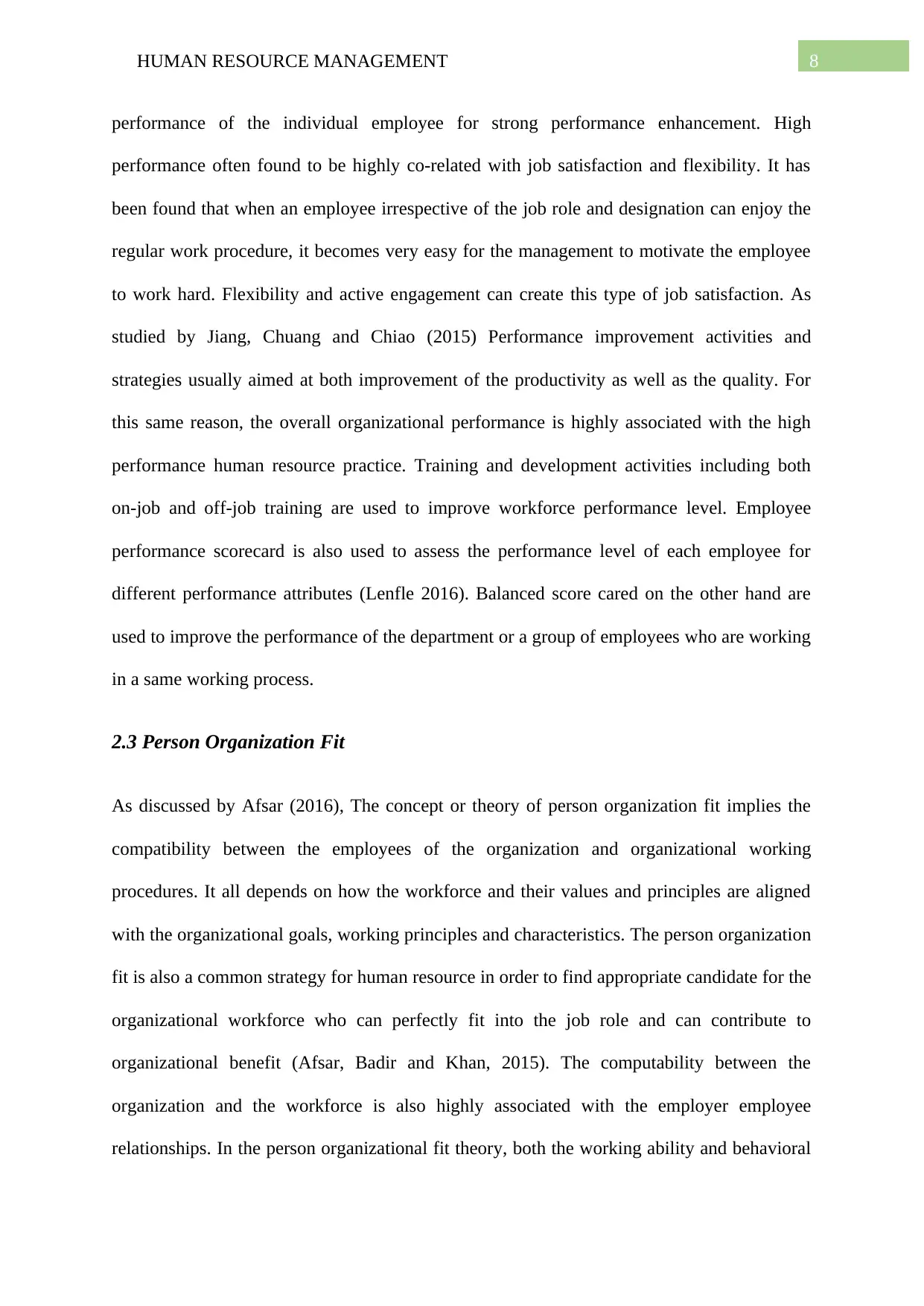
8HUMAN RESOURCE MANAGEMENT
performance of the individual employee for strong performance enhancement. High
performance often found to be highly co-related with job satisfaction and flexibility. It has
been found that when an employee irrespective of the job role and designation can enjoy the
regular work procedure, it becomes very easy for the management to motivate the employee
to work hard. Flexibility and active engagement can create this type of job satisfaction. As
studied by Jiang, Chuang and Chiao (2015) Performance improvement activities and
strategies usually aimed at both improvement of the productivity as well as the quality. For
this same reason, the overall organizational performance is highly associated with the high
performance human resource practice. Training and development activities including both
on-job and off-job training are used to improve workforce performance level. Employee
performance scorecard is also used to assess the performance level of each employee for
different performance attributes (Lenfle 2016). Balanced score cared on the other hand are
used to improve the performance of the department or a group of employees who are working
in a same working process.
2.3 Person Organization Fit
As discussed by Afsar (2016), The concept or theory of person organization fit implies the
compatibility between the employees of the organization and organizational working
procedures. It all depends on how the workforce and their values and principles are aligned
with the organizational goals, working principles and characteristics. The person organization
fit is also a common strategy for human resource in order to find appropriate candidate for the
organizational workforce who can perfectly fit into the job role and can contribute to
organizational benefit (Afsar, Badir and Khan, 2015). The computability between the
organization and the workforce is also highly associated with the employer employee
relationships. In the person organizational fit theory, both the working ability and behavioral
performance of the individual employee for strong performance enhancement. High
performance often found to be highly co-related with job satisfaction and flexibility. It has
been found that when an employee irrespective of the job role and designation can enjoy the
regular work procedure, it becomes very easy for the management to motivate the employee
to work hard. Flexibility and active engagement can create this type of job satisfaction. As
studied by Jiang, Chuang and Chiao (2015) Performance improvement activities and
strategies usually aimed at both improvement of the productivity as well as the quality. For
this same reason, the overall organizational performance is highly associated with the high
performance human resource practice. Training and development activities including both
on-job and off-job training are used to improve workforce performance level. Employee
performance scorecard is also used to assess the performance level of each employee for
different performance attributes (Lenfle 2016). Balanced score cared on the other hand are
used to improve the performance of the department or a group of employees who are working
in a same working process.
2.3 Person Organization Fit
As discussed by Afsar (2016), The concept or theory of person organization fit implies the
compatibility between the employees of the organization and organizational working
procedures. It all depends on how the workforce and their values and principles are aligned
with the organizational goals, working principles and characteristics. The person organization
fit is also a common strategy for human resource in order to find appropriate candidate for the
organizational workforce who can perfectly fit into the job role and can contribute to
organizational benefit (Afsar, Badir and Khan, 2015). The computability between the
organization and the workforce is also highly associated with the employer employee
relationships. In the person organizational fit theory, both the working ability and behavioral
⊘ This is a preview!⊘
Do you want full access?
Subscribe today to unlock all pages.

Trusted by 1+ million students worldwide
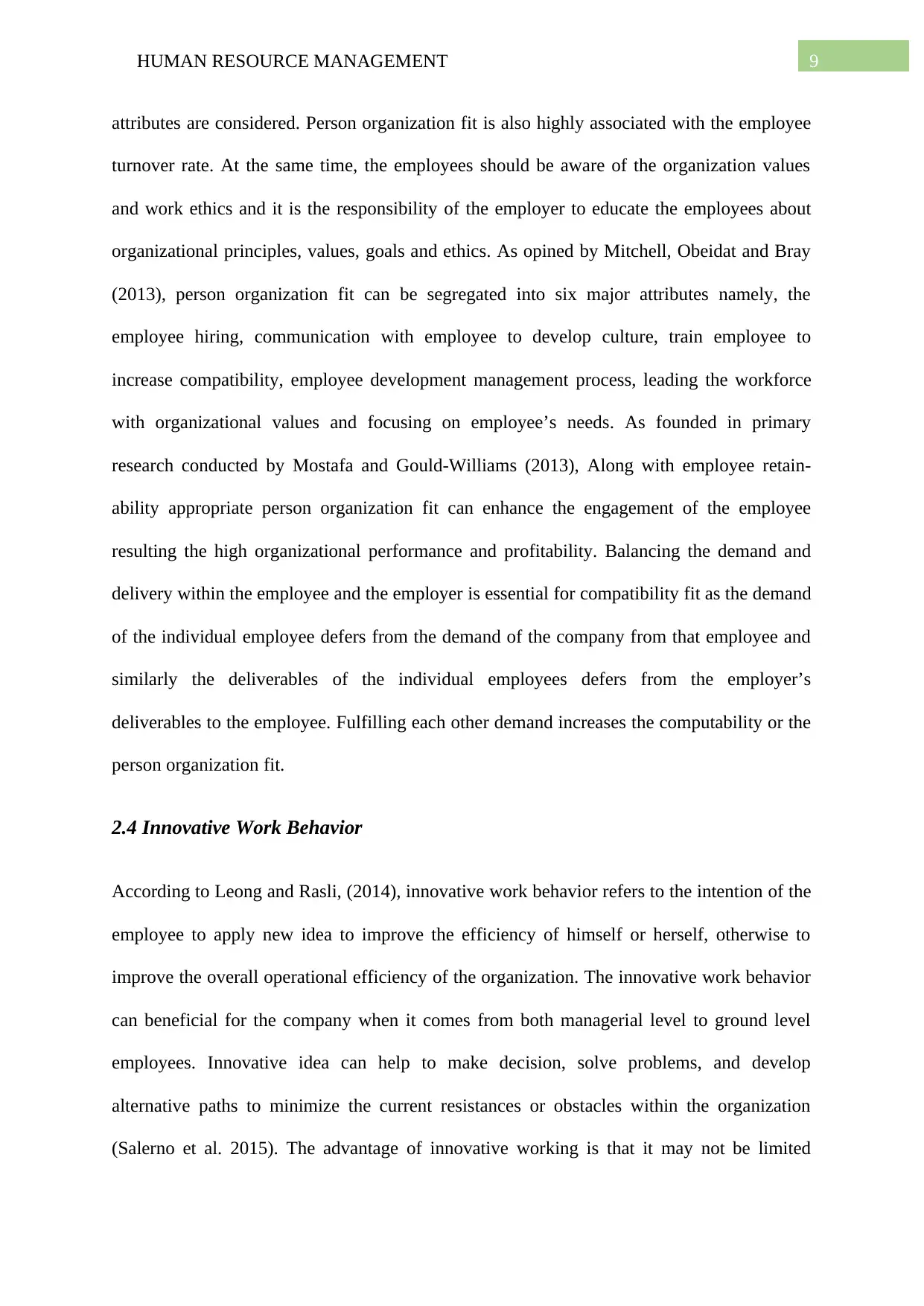
9HUMAN RESOURCE MANAGEMENT
attributes are considered. Person organization fit is also highly associated with the employee
turnover rate. At the same time, the employees should be aware of the organization values
and work ethics and it is the responsibility of the employer to educate the employees about
organizational principles, values, goals and ethics. As opined by Mitchell, Obeidat and Bray
(2013), person organization fit can be segregated into six major attributes namely, the
employee hiring, communication with employee to develop culture, train employee to
increase compatibility, employee development management process, leading the workforce
with organizational values and focusing on employee’s needs. As founded in primary
research conducted by Mostafa and Gould-Williams (2013), Along with employee retain-
ability appropriate person organization fit can enhance the engagement of the employee
resulting the high organizational performance and profitability. Balancing the demand and
delivery within the employee and the employer is essential for compatibility fit as the demand
of the individual employee defers from the demand of the company from that employee and
similarly the deliverables of the individual employees defers from the employer’s
deliverables to the employee. Fulfilling each other demand increases the computability or the
person organization fit.
2.4 Innovative Work Behavior
According to Leong and Rasli, (2014), innovative work behavior refers to the intention of the
employee to apply new idea to improve the efficiency of himself or herself, otherwise to
improve the overall operational efficiency of the organization. The innovative work behavior
can beneficial for the company when it comes from both managerial level to ground level
employees. Innovative idea can help to make decision, solve problems, and develop
alternative paths to minimize the current resistances or obstacles within the organization
(Salerno et al. 2015). The advantage of innovative working is that it may not be limited
attributes are considered. Person organization fit is also highly associated with the employee
turnover rate. At the same time, the employees should be aware of the organization values
and work ethics and it is the responsibility of the employer to educate the employees about
organizational principles, values, goals and ethics. As opined by Mitchell, Obeidat and Bray
(2013), person organization fit can be segregated into six major attributes namely, the
employee hiring, communication with employee to develop culture, train employee to
increase compatibility, employee development management process, leading the workforce
with organizational values and focusing on employee’s needs. As founded in primary
research conducted by Mostafa and Gould-Williams (2013), Along with employee retain-
ability appropriate person organization fit can enhance the engagement of the employee
resulting the high organizational performance and profitability. Balancing the demand and
delivery within the employee and the employer is essential for compatibility fit as the demand
of the individual employee defers from the demand of the company from that employee and
similarly the deliverables of the individual employees defers from the employer’s
deliverables to the employee. Fulfilling each other demand increases the computability or the
person organization fit.
2.4 Innovative Work Behavior
According to Leong and Rasli, (2014), innovative work behavior refers to the intention of the
employee to apply new idea to improve the efficiency of himself or herself, otherwise to
improve the overall operational efficiency of the organization. The innovative work behavior
can beneficial for the company when it comes from both managerial level to ground level
employees. Innovative idea can help to make decision, solve problems, and develop
alternative paths to minimize the current resistances or obstacles within the organization
(Salerno et al. 2015). The advantage of innovative working is that it may not be limited
Paraphrase This Document
Need a fresh take? Get an instant paraphrase of this document with our AI Paraphraser
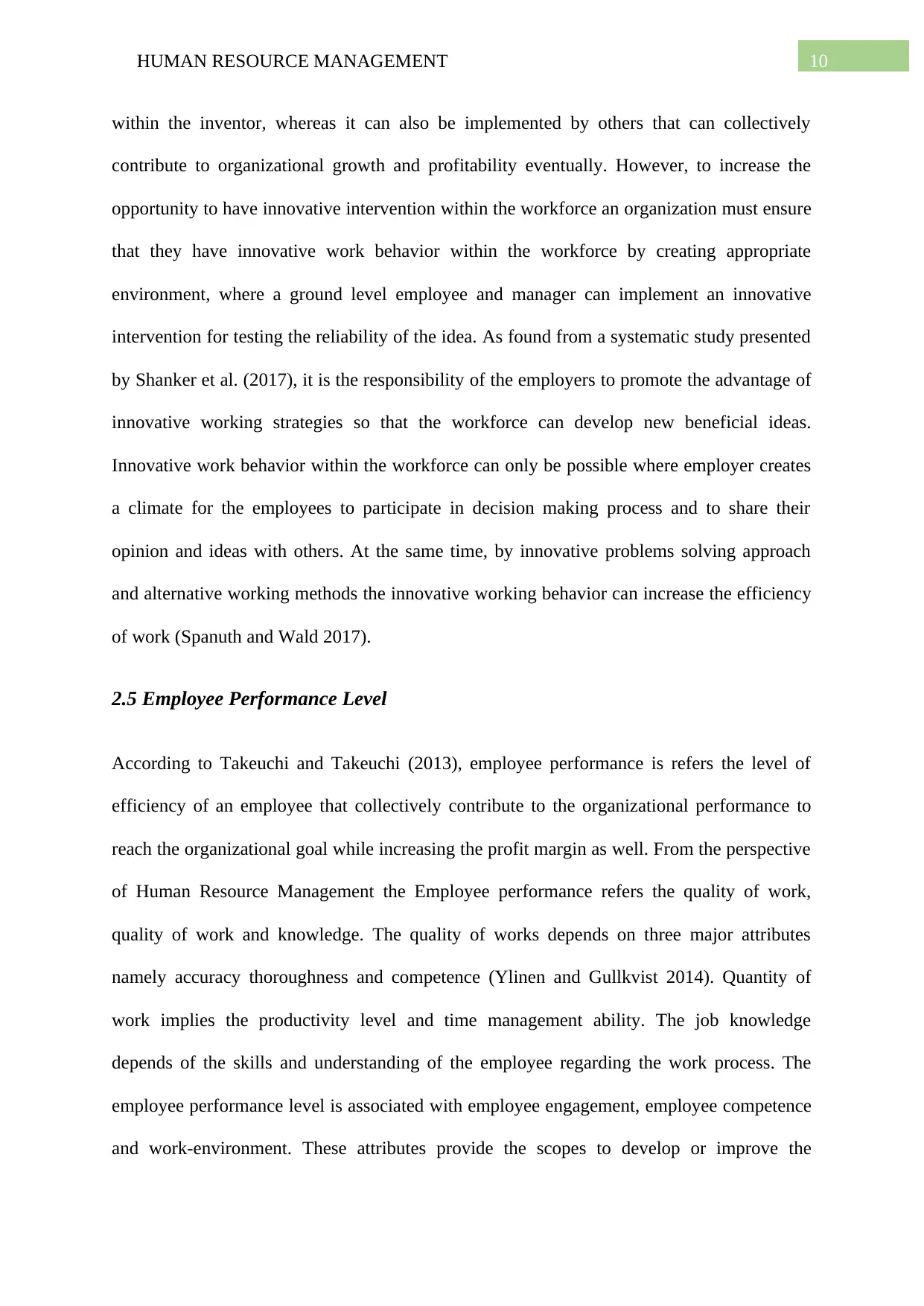
10HUMAN RESOURCE MANAGEMENT
within the inventor, whereas it can also be implemented by others that can collectively
contribute to organizational growth and profitability eventually. However, to increase the
opportunity to have innovative intervention within the workforce an organization must ensure
that they have innovative work behavior within the workforce by creating appropriate
environment, where a ground level employee and manager can implement an innovative
intervention for testing the reliability of the idea. As found from a systematic study presented
by Shanker et al. (2017), it is the responsibility of the employers to promote the advantage of
innovative working strategies so that the workforce can develop new beneficial ideas.
Innovative work behavior within the workforce can only be possible where employer creates
a climate for the employees to participate in decision making process and to share their
opinion and ideas with others. At the same time, by innovative problems solving approach
and alternative working methods the innovative working behavior can increase the efficiency
of work (Spanuth and Wald 2017).
2.5 Employee Performance Level
According to Takeuchi and Takeuchi (2013), employee performance is refers the level of
efficiency of an employee that collectively contribute to the organizational performance to
reach the organizational goal while increasing the profit margin as well. From the perspective
of Human Resource Management the Employee performance refers the quality of work,
quality of work and knowledge. The quality of works depends on three major attributes
namely accuracy thoroughness and competence (Ylinen and Gullkvist 2014). Quantity of
work implies the productivity level and time management ability. The job knowledge
depends of the skills and understanding of the employee regarding the work process. The
employee performance level is associated with employee engagement, employee competence
and work-environment. These attributes provide the scopes to develop or improve the
within the inventor, whereas it can also be implemented by others that can collectively
contribute to organizational growth and profitability eventually. However, to increase the
opportunity to have innovative intervention within the workforce an organization must ensure
that they have innovative work behavior within the workforce by creating appropriate
environment, where a ground level employee and manager can implement an innovative
intervention for testing the reliability of the idea. As found from a systematic study presented
by Shanker et al. (2017), it is the responsibility of the employers to promote the advantage of
innovative working strategies so that the workforce can develop new beneficial ideas.
Innovative work behavior within the workforce can only be possible where employer creates
a climate for the employees to participate in decision making process and to share their
opinion and ideas with others. At the same time, by innovative problems solving approach
and alternative working methods the innovative working behavior can increase the efficiency
of work (Spanuth and Wald 2017).
2.5 Employee Performance Level
According to Takeuchi and Takeuchi (2013), employee performance is refers the level of
efficiency of an employee that collectively contribute to the organizational performance to
reach the organizational goal while increasing the profit margin as well. From the perspective
of Human Resource Management the Employee performance refers the quality of work,
quality of work and knowledge. The quality of works depends on three major attributes
namely accuracy thoroughness and competence (Ylinen and Gullkvist 2014). Quantity of
work implies the productivity level and time management ability. The job knowledge
depends of the skills and understanding of the employee regarding the work process. The
employee performance level is associated with employee engagement, employee competence
and work-environment. These attributes provide the scopes to develop or improve the
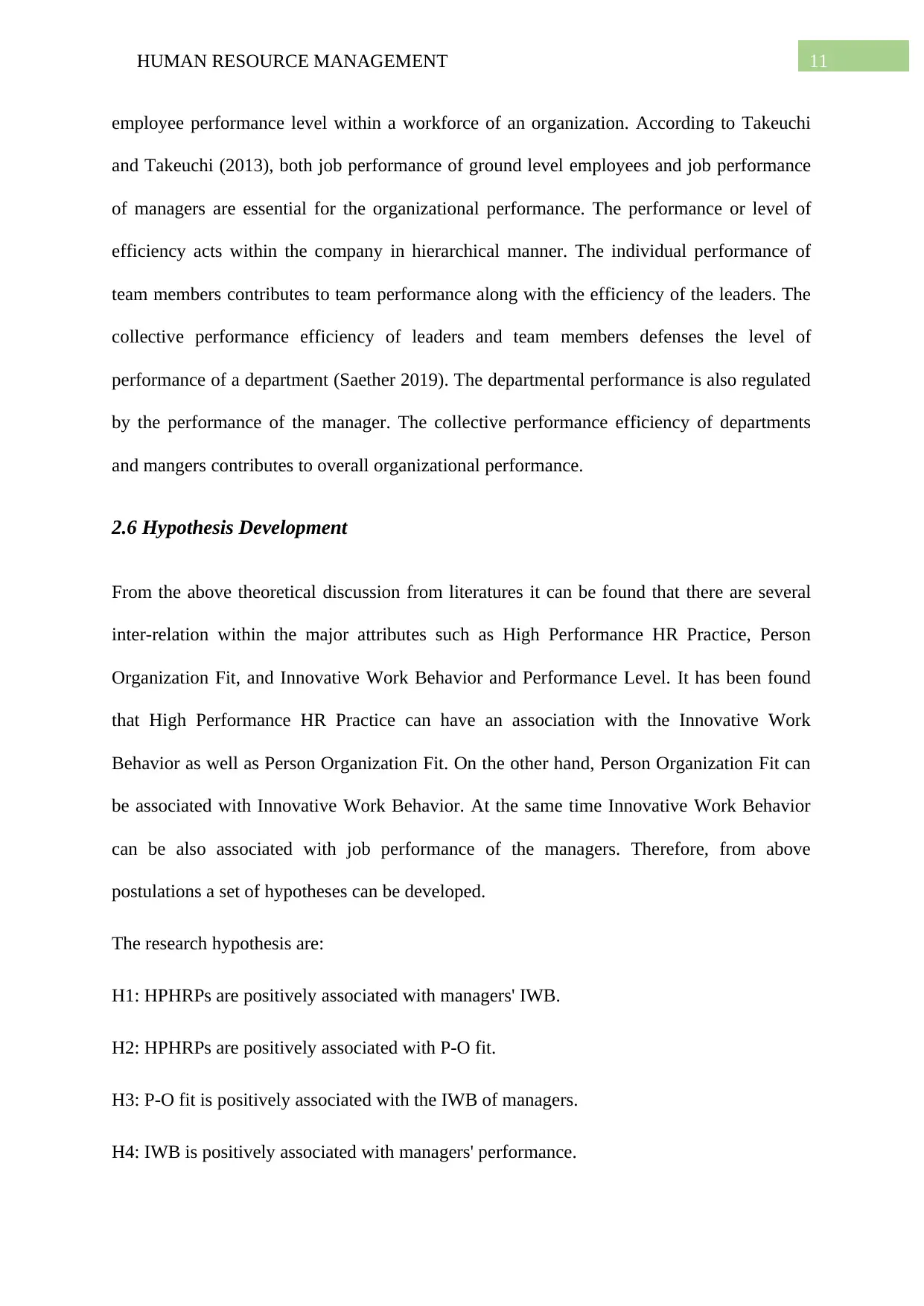
11HUMAN RESOURCE MANAGEMENT
employee performance level within a workforce of an organization. According to Takeuchi
and Takeuchi (2013), both job performance of ground level employees and job performance
of managers are essential for the organizational performance. The performance or level of
efficiency acts within the company in hierarchical manner. The individual performance of
team members contributes to team performance along with the efficiency of the leaders. The
collective performance efficiency of leaders and team members defenses the level of
performance of a department (Saether 2019). The departmental performance is also regulated
by the performance of the manager. The collective performance efficiency of departments
and mangers contributes to overall organizational performance.
2.6 Hypothesis Development
From the above theoretical discussion from literatures it can be found that there are several
inter-relation within the major attributes such as High Performance HR Practice, Person
Organization Fit, and Innovative Work Behavior and Performance Level. It has been found
that High Performance HR Practice can have an association with the Innovative Work
Behavior as well as Person Organization Fit. On the other hand, Person Organization Fit can
be associated with Innovative Work Behavior. At the same time Innovative Work Behavior
can be also associated with job performance of the managers. Therefore, from above
postulations a set of hypotheses can be developed.
The research hypothesis are:
H1: HPHRPs are positively associated with managers' IWB.
H2: HPHRPs are positively associated with P-O fit.
H3: P-O fit is positively associated with the IWB of managers.
H4: IWB is positively associated with managers' performance.
employee performance level within a workforce of an organization. According to Takeuchi
and Takeuchi (2013), both job performance of ground level employees and job performance
of managers are essential for the organizational performance. The performance or level of
efficiency acts within the company in hierarchical manner. The individual performance of
team members contributes to team performance along with the efficiency of the leaders. The
collective performance efficiency of leaders and team members defenses the level of
performance of a department (Saether 2019). The departmental performance is also regulated
by the performance of the manager. The collective performance efficiency of departments
and mangers contributes to overall organizational performance.
2.6 Hypothesis Development
From the above theoretical discussion from literatures it can be found that there are several
inter-relation within the major attributes such as High Performance HR Practice, Person
Organization Fit, and Innovative Work Behavior and Performance Level. It has been found
that High Performance HR Practice can have an association with the Innovative Work
Behavior as well as Person Organization Fit. On the other hand, Person Organization Fit can
be associated with Innovative Work Behavior. At the same time Innovative Work Behavior
can be also associated with job performance of the managers. Therefore, from above
postulations a set of hypotheses can be developed.
The research hypothesis are:
H1: HPHRPs are positively associated with managers' IWB.
H2: HPHRPs are positively associated with P-O fit.
H3: P-O fit is positively associated with the IWB of managers.
H4: IWB is positively associated with managers' performance.
⊘ This is a preview!⊘
Do you want full access?
Subscribe today to unlock all pages.

Trusted by 1+ million students worldwide
1 out of 38
Related Documents
Your All-in-One AI-Powered Toolkit for Academic Success.
+13062052269
info@desklib.com
Available 24*7 on WhatsApp / Email
![[object Object]](/_next/static/media/star-bottom.7253800d.svg)
Unlock your academic potential
Copyright © 2020–2025 A2Z Services. All Rights Reserved. Developed and managed by ZUCOL.




